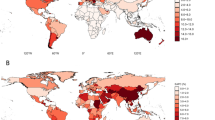Abstract
Rapid population aging is occurring in many parts of the developing world. Age structures are shifting from a relative concentration of younger to older individuals. Formal and informal health care needs across the developing world are changing concurrently. Therefore, population aging has enormous implications for health and social policy. This essay, which serves as an introduction to a special issue of Journal of Cross-Cultural Gerontology, highlights several critical research topics that require attention due to their implications for the health of individuals living in developing countries that are experiencing population aging. These include: population health levels, trends, and individual health transitions; influences of socioeconomic status on health and the consequences of rapidly changing socioeconomic structures for population health; and comparative studies on health and aging. Comparative research, in particular, has been underdeveloped and underutilized, but has great potential for providing insights into health determinants as well as the uniformity versus variation of the aging experience across societies. The remaining four papers that make up this special issue deal with these research topics and together highlight the complexity that exists in assessing individual and population health trends in developing countries that are undergoing population aging.
Similar content being viewed by others
References
Bengtson, V. L., Kyong-Dong, K., Myers, G. C., & Eun, K.-S. (Eds.) (2000). Aging in East and West: Families, states, and the elderly. New York: Springer.
Burgess, E. W. (Ed.). (1960). Aging in Western Societies. Chicago: University of Chicago Press.
Chi, I., Chappell, N. L., & Lubben, J. (Eds.) (2001). Elderly Chinese in Pacific Rim countries: Social support and integration. Hong Kong: Hong Kong University Press.
Colvez, A., & Blanchet, M. (1981). Disability trends in the United States population 1966–76: Analysis of reported causes. American Journal of Public Health, 71, 464–471.
Cowgill, D. O., & Holmes, L. D. (Eds.) (1972). Aging and modernization. New York: Appleton-Century-Crofts.
Frankenberg, E., Beegle, K., Sikoki, B., & Thomas, D. (1998). Health, family planning and well-being in Indonesia during an economic crisis: Early results from the Indonesian family life survey. Labor and Population Program Working Paper Series 99-06. Santa Monica, CA: RAND.
Freedman, V. A., Crimmins, E., Schoeni, R. F., Spillman, B. C., Aykan, H., Kramarow, E., et al. (2004). Resolving inconsistencies in trends in old-age disability: Report from a technical working group. Demography, 41, 417–441.
Fries, J. F. (1980). Aging, natural death and the compression of morbidity. New England Journal of Medicine, 303, 130–135.
Fry, C. L. (1997). Cross-cultural perspectives on aging. In K. F. Farrarro (Ed), Gerontology: Perspectives and issues, 2nd edition (pp. 138–154). New York: Springer.
Gruenberg, E. M. (1977). The failure of success. Milbank Memorial Fund Quarterly, 55, 3–24.
Haaga, J. (1993). The second Malaysian family life survey: Overview and technical report. Santa Monica, CA: RAND.
Hermalin, A. I. (2002). The well-being of the elderly in Asia: A four-country comparative study. Ann Arbor: The University of Michigan.
Hermalin, A. I., Ofstedal, M. B., & Chang, M.-C. (1996). Types of supports for the aged and their providers in Taiwan. In T. Hareven (Ed), Aging and generational relations over the life course: A historical and cross-cultural perspective (pp. 400–437). New York: Gruyter.
Liang, J., Liu, X., & Gu, S. (2001). Transitions in functional status among older people in Wuhan, China: Socioeconomic differentials. Journal of Clinical Epidemiology, 54, 1126–1138.
Link, B. G., & Phelan, J. (1995). Social conditions as fundamental causes of disease. Journal of Health and Social Behavior, 36, 80–94.
Manton, K. G. (1982). Changing concepts of morbidity and mortality in the elderly population. Milbank Memorial Fund Quarterly, 60, 183–244.
Mayhew, L. (1999). Health and welfare services expenditure in an aging world. In Interim Report # IR-99-035. Laxenburg, Austria: International Institute for Applied Systems Analysis.
National Research Council (2001). Preparing for an aging world: The case for cross-national research. Washington, DC: National Academy Press.
Palloni, A., Pinto-Aguirre, G., & Pelaez, M. (2002). Demographic and health conditions of ageing in Latin America and the Carribbean. International Journal of Epidemiology, 31, 762–771.
Preston, S. H. (1975). The changing relation between mortality and level of economic development. Population Studies, 29, 231–248.
Preston, S. H., & Taubman, P. (1994). Socioeconomic differences in adult mortality and health status. In L. G. Martin and S. H. Preston (Eds.), Demography of Aging (pp. 279–318). Washington: National Academic Press.
United Nations (2005). World population prospects: The 2004 revision. New York, NY: UN.
Verbrugge, L. M. (1984). Longer life but worsening health?: Trends in health and mortality of middle-aged persons. Milbank Memorial Fund Quarterly, 62, 475–519.
Zeng, Y., Vaupel, J. W., Zhenyu, X., Chunyuan, Z., & Yuzhi, L. (2001). The Healthy Longevity Survey and the Active Life Expectancy of the oldest old in China. Population: An English Selection, 13, 95–116.
Zimmer, Z., Chayovan, N., Lin, H.-S., & Natividad, J. (2004). How indicators of socioeconomic status relate to physical functioning of older adults in three Asian societies. Research on Aging, 26, 224–258.
Acknowledgement
This research was supported by Grant R01 AG20063-01 from the National Institute on Aging.
Author information
Authors and Affiliations
Corresponding author
Rights and permissions
About this article
Cite this article
Zimmer, Z., Martin, L.G. Key Topics in the Study of Older Adult Health in Developing Countries that are Experiencing Population Aging. J Cross Cult Gerontol 22, 235–241 (2007). https://doi.org/10.1007/s10823-007-9039-1
Published:
Issue Date:
DOI: https://doi.org/10.1007/s10823-007-9039-1




